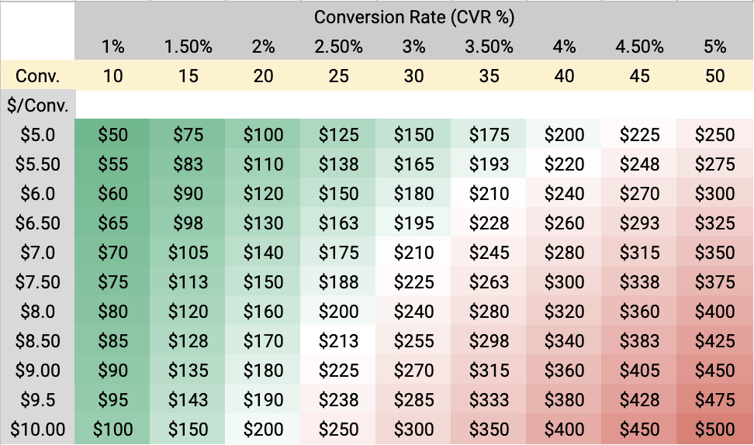Now more than ever, businesses are feeling the pressure to make the most of their marketing budgets. Inefficient activities that aren’t driving results are being reviewed with a critical eye. While some companies elect to slash marketing efforts, others are reallocating their budgets to activities with proven performance. If anything, we hope that your business is opting for the latter approach.
When you’re forced to cut your paid search and paid social advertising budgets, it’s imperative to get creative about making the most of what you have. We’ve put together some tips that can help you maximize the impact of your paid advertising and make more out of spending less.
Spending More Money On Advertising Isn't Always Necessary
First and foremost, it’s important to evaluate your ads with the proper context. Overall, your ad strategy should drive a mix of brand awareness, lead generation, and lead nurturing objectives. Comparing a lead generation campaign or ad set with brand awareness metrics could make you think you are paying too much on a CPM or CPC basis. However, your Cost Per Lead and Lead Volume could be fantastic. We see lead generation ads as a prime target to gain efficiencies, as they often represent the largest portion of a paid media budget.
Save Ad Budget for Higher Performing Ads
This sounds like a no-brainer, but you might be surprised at how much ad budget is thrown at ads that don’t yield many conversions or earn clicks at a hefty cost-per-click. Paid advertising managers should actively evaluate campaigns to understand which ad variations shine and which ones fall short of KPI goals.
The guidelines for what’s considered “underperforming” are gray, so we recommend that advertisers pay attention to their overall objective. One rule of thumb is to evaluate an ad after it receives 2,500 impressions; with that number of impressions, you’ll need 50 clicks to achieve a 2% conversion rate.
We evaluated one client’s current ad spend versus performance, and we found key ways to prevent their ad spend from being wasted. We reallocated the ad budget to other high-performing ads that needed more ad spend to increase lead volume. We were able to maintain the same ad budget, but we increased conversions by 80%.
If all ads in a group have earned conversions, we recommend pausing ads that have the highest cost/conversion compared to other ads. If the cost/conversion for all ads are pretty close, we suggest pausing ads with the lowest conversion rate to maximize your conversions for every dollar spent.
Make sure you evaluate ad performance at least weekly. An ad may have great metrics right now, but it doesn’t mean those conversion costs and conversion rates will stay the same over time. Your timing may depend on the amount of budget you plan to invest. We always test another 2-4 ads against the “champion” (or most successful) ad to ensure the ads don’t go stale. Try testing new creative that will trigger interest from different segments of your audiences at a lower cost
Trim Non-Essential Audiences
Before you decide to trim audiences, we strongly recommend evaluating your entire account performance to ensure one ad isn’t dragging down the entire audience. If nothing seems to gain traction after multiple experiments, it’s time to look at things on the broader level where audiences are set.
A recent pilot program for a client proved that trimming down audiences and focusing on a smaller target audience would generate more results at a cheaper cost. This strategy helped increase conversion rates 3X and generated 32% of all paid leads in a 90-day period with just three target markets.
Trimming Paid Social Audience Targeting
Paid social advertising platforms, such as Facebook, LinkedIn, Twitter, Snapchat, and Pinterest, allow you to set your audiences for each ad set (nested under “campaigns” in organizational structure). The naming of each sub-campaign group varies within each platform, but the concept remains the same. For the sake of this piece, we’ll call them “ad sets.”
To begin reducing ad spend on your paid social audiences, the easiest place to start is by trimming off ad sets and audiences that haven’t generated conversions, even after trying multiple ad creatives. Once these audiences are trimmed, if you still feel the need to reduce your targeting, it’s imperative to look at 30-90 day ranges to better understand which groups have lower conversion rates and higher costs per conversion. The chart matrix below shows you how many conversions you can expect at various conversion rates and conversion costs:

After analyzing where your ad sets and audiences fall in the “conversion rate vs. conversion cost” chart, you may want to trim and adjust to favor modifications with cheaper conversion costs:
- Mobile vs. desktop placements
- Facebook vs. Instagram placements
- Android vs. iOS
- Locations
- Age groups
- Household incomes
- Audience Network vs. Actual Social Feeds
Trimming Paid Search Audience Targeting
Paid search advertising targeting operates quite a bit differently than paid social platforms. There are a few different audience and targeting options you can look at that affect all campaign types:
Decisive Devices
Each campaign allows you to adjust your bids for three device types: mobile, desktop, and tablet. It’s best to look at your device performance over a 30-90 day period. You may notice that one device happens to bring in cheaper conversions compared to others. This is a great opportunity to conserve ad budget by reducing bids on underperforming devices.
Demographic Targeting
Depending on your persona targeting, it may be beneficial to exclude certain age ranges, genders, or household income demographics (especially if you’re doing anything with a B2C campaign). In a B2B campaign, an advertiser should consider excluding or reducing bids on the 18-24 age group if they’re looking to target audiences with more disposable income for an e-commerce campaign. On the B2B side, you’ll also want to exclude intern/entry level searchers if you’re trying to generate leads.
Location, Location, Location
Similar to device and demographic adjustments, paid search advertisers can adjust bids on certain locations or exclude locations altogether. For example, rather than targeting the United States as a country in Google Ads and Microsoft Ads, consider uploading states individually as location targets, then excluding or reducing bids where the ads underperform.
Keyword Matches
For search campaigns, your targeting revolves around keywords that are related to a certain topic. When you’re forced to reduce ad spend, it’s important to analyze historical performance of your keywords, especially broad-match keywords (to be honest, you should always be doing this). We recommend looking at search terms that trigger ads based on each broad keyword to determine if there are any phrases that consistently generate conversions. Try to single out the keywords that drive the most conversions and pause the keywords that generate dead-end clicks.
Eliminate Audience Network
Similar to some paid social platforms, you can expand your reach via “audience network” targeting. While this expanded reach can get you more clicks at a cheaper cost, the quality of the traffic is usually very poor. Even if you’re working with an unconstrained budget, we’d suggest you steer clear of audience network targeting unless the data proves you should continue to target expanded networks.
Pick Audiences Wisely
Especially for display and video advertising, you can choose to target audiences put together by Google or Microsoft (such as custom intent or affinity audiences), as well as custom audiences. We recommend you understand how each audience impacts your PPC performance. If one converts at a higher cost than another, it might be time to pause that audience target when your paid ad budgets are slashed.
Change Bidding Structures
Changing up your bidding strategy can be one of the most effective ways to cut unnecessary costs across all paid ad platforms. More often than not, the tech giants will encourage you to create smart or automated campaigns that encourage quick and easy set up, making you feel like your ads are in a “set it and forget it” mode. This is one of the easiest ways to bleed dollars and see very little return.
When you choose to optimize conversions, it’s imperative that your tracking pixels have enough data to inform good decisions. If all of your efforts don’t lead to at least 50 conversions per month, the artificial intelligence logic won’t be able to deliver ads to users that are most likely to convert. Target CPA optimizations fall in this category, as well. If there aren’t enough conversions to drive educated decisions, you’re going to overspend as the algorithms try to figure things out.
It’s best to start off with a “maximize clicks” or “manual bidding” structure, where you set your ideal price per click. As you begin to get more impressions, clicks, and conversions, you can decide if you’re ready for a different bidding strategy.
Improve Landing Page Experiences
Have you ever gone through the ad experience you’re sending your target audience through? When you’re trying to reduce costs, fixing your landing page experiences by optimizing conversion rates can improve performance further up the chain. By making adjustments, you can improve your conversion rates, cost per conversion, and in the realm of search advertising, improve quality scores that earn you higher positions at cheaper costs.
Smarter Content
When optimizing your landing pages, it’s important to ensure that the content on each page is relevant to the people you’re driving to the page. If your advertisement promotes a specific product feature or service benefit, you better make sure you lead with that content on your landing page! More importantly, your content may resonate with different persona types if it’s presented in different ways. We work with landing page tools such as Hubspot and Unbounce. They make it easy to adjust copy based on user information to provide relevant experiences that drive conversions.
Identifiable CTAs
It’s frustrating when you reach a dead-end; when you don’t know what action to take to move forward. This especially applies to landing pages. If a user doesn’t know where to click or what to do to get to the next phase of their digital experience, they’re going to leave the page and look for help elsewhere. Make sure to include calls-to-action (CTAs) that clearly explain what will happen when someone clicks on them. This simple step will increase conversions and reduce the cost it takes for someone to convert.
Reorganize Layouts
Just like with the calls-to-action, you need to make sure your information is easy-to-read and neatly presented. If your content doesn’t flow in an order that educates users about what they can expect, you’re going to lose site visitors one by one. When your content is laid out in a strategic way, you’ll find that users feel more comfortable submitting their information or purchasing your product. It doesn’t hurt to A/B test layouts, such as including a form at the top of the page versus in the footer, to learn what drives more conversions and lower conversion costs.
What's Next?
By adjusting ads, audiences, bids, and landing page experiences, you can find ways to drastically reduce costs when you’re facing reduced or capped advertising budgets. If your business goes through a rough patch and needs to make cuts, every ad dollar needs to be an ad dollar well spent. We never recommend fully cutting your advertising and marketing budgets, as that means pulling back on all efforts that help customers find you and stabilize your operations.
A lot of thought goes into running successful advertising campaigns. If you’re ready to make every dollar count, it’s a perfect time to talk to Airfoil Digital for a consultation. We can talk you through a strategic plan to make the most of your marketing budgets and maximize your return on investment.





